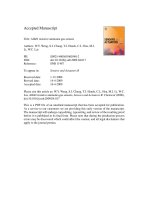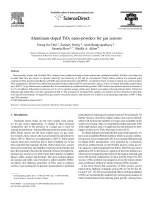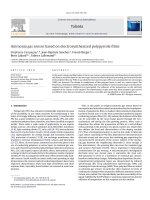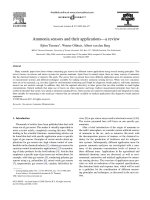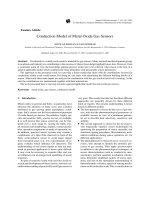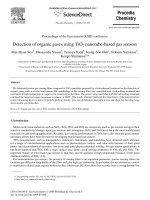- Trang chủ >>
- Khoa Học Tự Nhiên >>
- Vật lý
alinn resistive ammonia gas sensors
Bạn đang xem bản rút gọn của tài liệu. Xem và tải ngay bản đầy đủ của tài liệu tại đây (2.14 MB, 19 trang )
Accepted Manuscript
Title: AlInN resistive ammonia gas sensors
Authors: W.Y. Weng, S.J. Chang, T.J. Hsueh, C.L. Hsu, M.J.
Li, W.C. Lai
PII: S0925-4005(09)00340-2
DOI: doi:10.1016/j.snb.2009.04.017
Reference: SNB 11487
To appear in: Sensors and Actuators B
Received date: 1-12-2008
Revised date: 14-4-2009
Accepted date: 16-4-2009
Please cite this article as: W.Y. Weng, S.J. Chang, T.J. Hsueh, C.L. Hsu, M.J. Li, W.C.
Lai, AlInN resistive ammonia gas sensors, Sensors and Actuators B: Chemical (2008),
doi:10.1016/j.snb.2009.04.017
This is a PDF file of an unedited manuscript that has been accepted for publication.
As a service to our customers we are providing this early version of the manuscript.
The manuscript will undergo copyediting, typesetting, and review of the resulting proof
before it is published in its final form. Please note that during the production process
errors may be discovered which could affect the content, and all legal disclaimers that
apply to the journal pertain.
Page 1 of 18
Accepted Manuscript
1
AlInN resistive ammonia gas sensors
W. Y. Weng
1
, S. J. Chang
1
, T. J. Hsueh
2,*
C. L. Hsu
3
, M. J. Li
3
and W. C. Lai
4
1
Institute of Microelectronics and Department of Electrical Engineering
Advanced Optoelectronic Technology Center
Center for Micro/Nano Science and Technology
National Cheng Kung University, Tainan 70101, TAIWAN
2
National Nano Device Laboratories, Tainan 741, Taiwan.
3
Department of Electronic Engineering National University of Tainan,
Tainan 700, TAIWAN
4
Institute of Electro-Optical Science and Engineering, National Cheng
Kung University, Tainan 70101, TAIWAN
Abstract
We report the growth of AlInN epitaxial layer and the fabrication of
AlInN resistive NH
3
gas sensor. It was found that surface morphology of
the AlInN was rough with quantum dot like nano-islands. It was also
found that the conductance of these AlInN nano-islands increased as NH
3
gas was introduced into the test chamber. At 350
o
C, it was found that
measured incremental currents were around 105
μA, 127 μA, 147 μA and
157
μA when concentration of the injected NH
3
gas was 500, 1000, 2000
and 4000 ppm, respectively.
Keywords: AlInN, nano-island, gas sensor, ammonia sensor
Email:
TEL: (+886) 6-2757575-62400-1208 ; FAX: (+886) 6-2761854
Page 2 of 18
Accepted Manuscript
2
Introduction
Ammonia (NH
3
) is a colorless gas with a special odor. It is commonly
used in various industrial sectors [1]. Although NH
3
is extensively used in
our daily life, people may develop a burning sensation in eyes, nose and
throat when exposed to NH
3
. Inhalation of NH
3
vapor could also cause
acute poisoning to people. Hence, detecting and measuring NH
3
vapor
concentration in the environment is necessary. The most commonly used
method to detect gaseous NH
3
was either by potentiometric electrodes [2]
or by infrared devices [3]. However, these devices are expensive and bulky.
It is also possible to detect NH
3
vapor concentration by semi-conducting
metal oxide materials [4-9]. It has been shown that near surface
conductivity of these materials changes upon exposure to certain gas
molecules. Furthermore, it was found that such resistance change is
related to various defects such as oxygen vacancy, metal vacancy or others
[10, 11].
Recently, it was found that III-nitride epitaxial layer can also be used
to detect gaseous butane, propane, ethyl alcohol and carbon monoxide
[12]. Although III-nitride-based materials are extensively used as light
emitting diodes [13, 14], ultraviolet photodetectors [15] and high power
electronics [16], only few reports on III-nitride-based sensor for volatile
organic compounds can be found in the literature [12]. Compared with
metal oxide sensors, we should be able to integrate III-nitride-based gas
sensors with III-nitride-based photodetectors and electronic devices on the
same chip. Other than the binary GaN, ternary AlInN has attracted much
Page 3 of 18
Accepted Manuscript
3
attention in recent years. Compared with AlGaN and InGaN, AlInN is
much less known due to the difficulty in growing high quality crystal [17].
It has been shown that AlInN can be grown lattice matched to GaN with
an indium content of ~17-18%. However, it is still difficult to grow high
quality AlInN due to severe phase separation caused by the large disparity
in cation sizes as well as by differences in thermal properties of the binary
constituents [18]. It has also been reported that epitaxial AlInN layers are
defective in general with a significant amount of aluminum vacancy,
indium vacancy or nitrogen vacancy. Similar to metal oxide sensors, these
defects should be able to enhance the reaction of gas molecular on sample
surface and thus enhance the responsivity of AlInN-based gas sensors. In
this study, we report the growth of AlInN. Sensing properties of the
fabricated AlInN resistive NH
3
gas sensors will also be discussed.
Experimental
Samples used in this study were grown on a c-plane (0001) sapphire
(Al
2
O
3
) substrate by metalorganic chemical vapor deposition. Details of
the growth can be found elsewhere [19]. Prior to the growth, we annealed
the sapphire substrates at 1060°C in H
2
ambient to remove surface
contamination. We then deposited a 30-nm-thick low-temperature GaN
nucleation layer at 530°C, a 2-
μm-thick n-type unintentionally doped GaN
(n=3×10
16
cm
-3
) buffer layer at 1020°C, and a 500-nm-thick n-type
unintentionally doped AlInN (n=5×10
19
cm
-3
) active layer at 650°C. A
JEOL JSM-7000F field emission scanning electron microscope (FESEM)
operated at 10 keV was then used to characterize structural properties of
Page 4 of 18
Accepted Manuscript
4
the as-grown AlInN epitaxial layer. The cross-sectional image of the
AlInN layer was prepared by an FEI Nova-200 NanoLab Dual-Beam
Focused Ion Beam (DB-FIB) system. Crystal qualities of the as-grown
samples were evaluated by a BEDE D1 double-crystal X-ray diffraction
(DCXRD) system. The source of X-ray is 1.54056 Å wavelength (Cu K
α
).
For the fabrication of NH
3
gas sensors, we carefully smeared the
colloidal silver onto the sample surface to serve as contact electrodes. The
sample was then annealed at 350°C for 15 min in Ar ambient to form good
ohmic contacts between sliver and the underlying AlInN. Figure 1 shows
schematic diagram of the fabricated AlInN resistive gas sensor. To
evaluate NH
3
gas sensing properties, we placed the fabricated sensor in a
sealed chamber and measured current-voltage (I-V) characteristic of the
sample in air from the two electrodes. It should be noted that the sealed
chamber has an inlet port connected to a gas inlet valve and an outlet port
connected to an air pump. We first closed the outlet port and injected NH
3
gas into the chamber through a gas-injecting syringe. At this stage, we
measured I-V characteristic of the sample continuously in the presence of
NH
3
gas (i.e., air+ NH
3
). After the chamber was stabilized, we opened the
outlet port so that the air pump can pump the NH
3
gas away. At the same
time, we also opened the inlet valve to introduce air into the chamber. In
other words, the chamber was kept in atmospheric pressure throughout the
experiment. At the end of the experiment, we measured I-V characteristic
of the sample in air again.
Result and Discussion
From Hall measurements, it was found that the sheet resistances of our
GaN and AlInN layers were 1.09×10
6
Ω/sq and 394 Ω/sq, respectively.
Page 5 of 18
Accepted Manuscript
5
These values suggest that parallel conduction which might occur in the
GaN buffer layer should be negligible. Figure 2 shows top-view FESEM
image of the AlInN epitaxial layer. The inset shows cross-sectional image
of the AlInN layer that prepared by DB-FIB. It was found that thickness of
the AlInN epitaxial layer was around 545 nm, which agreed well with our
initial design. It was also found that surface morphology of the AlInN was
rough with quantum dot like nano-islands. Similar result has also been
reported previously [20]. It also was found that the diameter and height of
the nano-islands were around 100 nm and 160 nm, respectively. It should
be noted that these nano-islands could provide us a larger surface area,
which in term will result in a large sensor response. It should also be noted
that the Pt layer shown in the inset was intentionally deposited to protect
the underneath AlInN and GaN from e-beam etching during DB-FIB
sample preparation. No such Pt layer was used during the fabrication of
NH
3
sensors. Figure 3(a) shows DCXRD spectrum of the sample with two
clear peaks. It was found that full-width-half-maximum (FWHM) of the
(0002) GaN peak was around 130 arcsec, suggesting good crystal quality.
In contrast, FWHM of the AlInN peak was significantly larger (i.e., 758
arcsec). Based on Vegard’s rule, it was found that indium content in the
AlInN layer was around 62%. The fact that no other peaks were observed
suggests that no phase separation occurred in the sample [21]. Figure 3(b)
shows energy dispersive spectrum (EDS) measured from the fabricated
devices. It can be seen that aluminum, indium and nitrogen peaks could all
be clearly observed in the spectrum. It was also found that the atomic
weight percent of indium in the AlInN layer was 62.6%, which agrees well
with that observed from the DCXRD measurement.
Page 6 of 18
Accepted Manuscript
6
Figure 4 shows I-V characteristics of the fabricated sensor measured in
air. It can be seen that the measured current increased linearly with the
applied bias. Such linear behavior reveals that good ohmic contacts were
formed between the Ag electrodes and the AlInN epitaxial layer. For gas
sensing, it is known that oxygen is adsorbed at the N vacancies of
III-nitrides semiconductors [12]. Thus, oxygen sorption plays an
important role in electrical transport properties of AlInN epitaxial layer. It
is also known that oxygen ionosorption removes conduction electrons and
thus lowers the conductance of AlInN. Hence, the sensing mechanism of
AlInN NH
3
gas sensor may be described as follows: First, reactive oxygen
species such as O
2
−
, O
2−
and O
−
are adsorbed on AlInN surface at elevated
temperatures. It should be noted that chemisorbed oxygen species depend
strongly on temperature. At low temperatures, O
2
−
is commonly
chemisorbed. At high temperatures, however, O
−
and O
2−
are commonly
chemisorbed while O
2
−
disappear rapidly [22]. The reaction kinematics
can be described as follows [23]:
O
2
(gas) ↔ O
2
(absorbed) (1)
O
2
(absorbed) + e
−
↔ O
2
−
(2)
O
2
−
+e
−
↔ 2O
−
(3)
Thus, the conductance of AlInN nano-islands increased as NH
3
gas was
introduced into the test chamber due to the exchange of electrons between
ionosorbed species and AlInN nano-islands. The reaction between NH
3
gas and the ionic oxygen species can be described by [24]:
2NH
3
+ 3O
−
(ads) ↔ 3H
2
O + N
2
+ 3e
−
(4)
Page 7 of 18
Accepted Manuscript
7
Figure 5 shows response of the fabricated AlInN NH
3
gas sensor
measured with 2000 ppm NH
3
gas at various temperatures. Here, we
define the response as the incremental current,
∆I, before and after the
introduction of NH
3
gas. With this definition, it was found that measured
∆I were around 15 μA, 52.5 μA, 75.4 μA, 147 μA and 60 μA when the
device was operated at 200
o
C, 250
o
C, 300
o
C, 350
o
C and 400
o
C,
respectively. Figure 6 shows response variation of the AlInN sensor
exposed to NH
3
gas injection and pumping. These measurements were
performed by injecting various amounts of NH
3
gas into the sealed
chamber following by pumping at 350
o
C. It was found that measured
sensor responses were around 105
μA, 127 μA, 147 μA and 157 μA when
concentration of the injected NH
3
gas was 500, 1000, 2000 and 4000 ppm,
respectively. In other words, sensor response increased with the increase
of NH
3
gas concentration. It was also found that measured sensor response
rapidly as we injected NH
3
gas into the chamber and pumped them away.
Such a result indicates that the response speed of the fabricated sensor is
good.
Conclusion
In summary, we report the growth of AlInN epitaxial layer and the
fabrication of AlInN resistive NH
3
gas sensor. It was found that surface
morphology of the AlInN was rough with quantum dot like nano-islands.
It was also found that the conductance of these AlInN nano-islands
increased as NH
3
gas was introduced into the test chamber. At 350
o
C, it
Page 8 of 18
Accepted Manuscript
8
was found that measured incremental currents were around 105 μA, 127
μA, 147 μA and 157 μA when concentration of the injected NH
3
gas was
500, 1000, 2000 and 4000 ppm, respectively.
Acknowledgements: This work was granted by the Center for Frontier
Materials and Micro/Nano Science and Technology, National Cheng
Kung University, Taiwan (D97-2700). This work was also in part
supported by the Advanced Optoelectronic Technology Center, National
Cheng Kung University, under projects from the Ministry of Education.
Page 9 of 18
Accepted Manuscript
9
Figure Captions
Figure 1. Schematic diagram of the fabricated AlInN resistive gas sensor
Figure 2. Top-view FESEM image of the AlInN epitaxial layer. The inset
shows cross-sectional image of the AlInN layer.
Figure 3. (a) DCXRD and (b) EDS spectra of the AlInN layer.
Figure 4. I-V characteristics of the fabricated sensor measured in air.
Figure 5. Response of the fabricated AlInN NH
3
gas sensor measured with
2000 ppm NH
3
gas at various temperatures.
Figure 6. Response variation of the AlInN sensor exposed to NH
3
gas
injection and pumping.
Page 10 of 18
Accepted Manuscript
10
References
[1] C. Malins, A. Doyle, B. D. MacCraith, F. Kvasnik, M. Landl, P. Simon,
L. Kalvoda, R. Lukas, K. Pufler and I. Babusik, Personal ammonia
sensor for industrial environments, J. Environ. Monit. 1 (1999)
417-422.
[2] M. E. Meyerhoff, Polymer membrane electrode-based potentiometric
ammonia gas sensor, Anal. Chem
. 52 (1980) 1532-1534.
[3] P. S. Kumar, A. V. Scaria, C. P. G. Vallabhan, V. P. N. Nampoori and P.
Radhakrishnan, Long-period grating in multimode fiber for ammonia
gas detection, Proc. SPIE. 5279, (2004) 331-335.
[4] Y. D. Wang, X. H. Wu, Q. Su, Y. F. Li and Z. L. Zhou,
Ammonia-sensing characteristics of Pt and SiO
2
doped SnO
2
materials,
Solid-State Electron. 45 (2001) 347-350.
[5] A. K. Prasad, P. I. Gouma, D. J. Kubinski, J. H. Visser, R. E. Soltis and
P. J. Schmitz, Reactively sputtered MoO
3
films for ammonia sensing,
Thin Solid Films. 436 (2003) 46-51.
[6] G. S. T. Rao and D. T. Rao, Gas sensitivity of ZnO based thick film
sensor to NH
3
at room temperature, Sens. Actuators B 55 (1999)
166-169.
[7] V. Srivastava amd K.Jain, Highly sensitive NH
3
sensor using Pt
catalyzed silica coating over WO
3
thick films, Sens. Actuators B 133
(2008) 46-52.
[8] P. Guo and H. Pan, Selectivity of Ti-doped In
2
O
3
ceramics as an
ammonia sensor, Sens. Actuators B 114 (2006) 762-767.
[9] B. Karunagaran, P. Uthirakumar, S. J. Chung, S. Velumani and E. K.
Suh, TiO
2
thin film gas sensor for monitoring ammonia, Mater.
Page 11 of 18
Accepted Manuscript
11
Characterization 58 (2007) 680-684.
[10] K. Ihokura and J. Watson, “The performance of the stannic oxide
ceramic gas sensor, in: The stannic oxide gas sensor: Principles and
applications”, CRC press, Boca Raton, 1994.
[11] K. Ihokura and J. Watson, “Sensitivity modification using additives,
in: The Stannic Oxide Gas Sensor: Principles and Applications”, CRC
press, Boca Raton, 1994.
[12] D. S. Lee, J. H. Lee, Y. H. Lee, and D. D. Lee, GaN thin films as gas
sensors, Sens. Actuators B 89 (2003) 305-310.
[13] S. Nakamura, M. Senoh, N. Iwasa and S. Nagahama, High-power
InGaN single-quantum-well-structure blue and violet light-emitting
diodes, Appl. Phys. Lett. 67 (1995) 1868-1870.
[14] S. J. Chang, W. C. Lai, Y. K. Su, J. F. Chen, C. H. Liu and U. H. Liaw,
InGaN/GaN multiquantum well blue and green light emitting diodes,
IEEE J. Sel. Top. Quan. Electron
. 8 (2002) 278-283.
[15] S. J. Chang, M. L. Lee, J. K. Sheu, W. C. Lai, Y. K. Su, C. S. Chang,
C. J. Kao, G. C. Chi and J. M. Tsai, GaN metal-semiconductor-metal
photodetectors with low-temperature GaN cap layers and ITO metal
contacts, IEEE Electron. Dev. Lett. 24 (2003) 212-214.
[16] M. A. Khan, X. Hu, G. Sumin, A Lunev, J. Yang, R. Gaska and M. S.
Shur, AlGaN/GaN metal oxide semiconductor heterostructure field effect
transistor, IEEE Electron Dev. Lett. 21 (2000) 63-65.
[17] R. Butte, J. F. Carlin, E. Feltin, M. Gonschorek, S. Nicolay, G.
Christmann, D. Simeonov, A. Castiglia, J. Dorsaz, H. J. Buehlmann, S.
Christopoulos, G. B. H. von Hoegersthal, A. J. D. Grundy, M. Mosca, C.
Pinquier, M. A. Py, F. Demangeot, J. Frandon, P. G. Lagoudakis, J. J.
Page 12 of 18
Accepted Manuscript
12
Baumberg and N. Grandjean, Current status of AlInN layers
lattice-matched to GaN for photonics and electronics, J. Phys. D 40
(2007) 6328-6344.
[18] C. Hums, J. Bläsing, A. Dadgar, A. Diez, T. Hempel, J. Christen and
A. Krost, Metal-organic vapor phase epitaxy and properties of AlInN
in the whole compositional range , Appl. Phys. Lett. 90 (2007)
022105.
[19] S. J. Chang, C. H. Kuo, Y. K. Su, L. W. Wu, J. K. Sheu, T. C. Wen, W.
C. Lai, J. F. Chen and J. M. Tsai, 400nm InGaN/GaN and
InGaN/AlGaN multiquantum well light-emitting diodes, IEEE J. Sel.
Top. Quan. Electron. 8 (2002) 744-748.
[20] T. S. Tae, J. O. Kim, H. Jeong, Y. S. Lee, S. Nagarajan, K. Y. Lim, C.
H. Hong and E. K. Suh, Growth and properties of Al-rich In
x
Al
1-x
N
ternary alloy grown on GaN template by metalorganic chemical
vapour deposition, J. Phys. D 41 (2008) 095402.
[21] S. Schmult, T. Siegrist, A. M. Sergent and M. J. Manfra, Optimized
growth of lattice-matched In
x
Al
1−x
N/GaN heterostructures by
molecular beam epitaxy, Appl. Phys. Lett. 90 (2007) 021922.
[22] D. Kohl, The role of noble-metals in the chemistry of solid-state gas
sensors, Sens. Actuators B 1 (1990) 158-162.
[23] P. P. Sahay, Zinc oxide thin film gas sensor for detection of acetone, J.
Mater. Sci. 40 (2005) 4383-4385.
[24] M. S. Wagh, G. H. Jain, D. R. Patil, S. A. Patil and L. A. Patil,
Modified zinc oxide thick film resistors as NH
3
gas sensor, Sens.
Actuators B 115 (2006) 128-133.
Page 13 of 18
Accepted Manuscript
13
Biography
Wen-Yin Weng received the B.S. degree in Department of Electrical Engineering
from National University of Kaohsiung, Kaohsiung, Taiwan, in 2006, and the M.S.
degree in 2008 from the Institute of Electro-Optical Science and Engineering, National
Cheng Kung University (NCKU), Tainan, where he is currently working toward the
Ph.D. degree at the Institute of Microelectronics and Department of Electrical
Engineering, Advanced Optoelectronic Technology Center, Center for Micro/Nano
Science and Technology. His current research interests include optoelectronics device
of III–V compound semiconductors.
Shoou-Jinn Chang received his B.S.E.E. degree from National Cheng Kung
University (NCKU), Tainan, Taiwan in 1983, M.S.E.E. degree from State University
of New York, Stony Brook in 1985 and Ph.D.E.E. from University of California, Los
Angeles in 1989. Currently, he is a full professor with the Department of Electrical
Engineering, NCKU. He also serves as the Director of Semiconductor Research Center
in NCKU. His research interests include nanotechnology, semiconductor physics and
optoelectronic devices.
Ting-Jen Hsueh received the M.S. degree in electrical engineering from the National
Kaohsiung University of Applied Sciences, Kaohsiung, in 2004, and the Ph.D. degree
in microelectronics from the National Cheng Kung University (NCKU), Tainan,
Taiwan, in 2008. From 2008 Septembers to 2009 Januaries, he was a Postdoctoral
Researcher with the Institute of Microelectronics, Advanced Opto-electronic
Technology Center, Center for Micro/Nano Science and Technology, NCKU.
He is currently a Postdoctoral Researcher with the National Nano Device Laboratories
(NDL). His current research interests include nanoscale 1-D semiconductors and solar
cells.
Cheng-Liang Hsu received the B.S. degree in electronic engineering from Chung
Yuan Christian University, Chung-Li, Taiwan in 1996. He received the M.S. degrees
in 1998 from the Department of Electronic Engineering, National Taiwan University
of Science and Technology, Taipei, Taiwan, and received the doctorate in 2005 from
the Department of Electrical Engineering, National Cheng Kung University, Tainan,
Taiwan. From 2000 to 2003, he was an Engineer with the Taiwan Semiconductor
Manufacturing Company. From 2003 to 2005, he was with the Material Research
Laboratories of Industrial Technology Research Institute. From 2005 to 2006, he
joined the Department of Electrical & Electronic Engineering, Ming Chi University of
Page 14 of 18
Accepted Manuscript
14
Technology, Taiwan as an Assistant Professor. In 2006, he joined the Department of
Electronics Engineering, National University of Tainan, Taiwan as an Assistant
Professor. His current research interests focus on nanoscale one-dimensional
semiconductors.
Meng-Ju Li received the B.S. degree in physics from Soochow University, Taipei,
Taiwan, in 2007 . He is currently working toward the M.S. degree at the Graduate
Institute of Electro-Optical Engineering, National University of Tainan, Tainan. His
current research interests include nanoscale 1-D semiconductors
Wei. Chih. Lai received the B.S. degree in electrical engineering from the Feng Chia
University, Taiwan, R.O.C., in 1993, and the M.S. and the Ph.D. degrees in electrical
engineering from National Cheng Kung University (NCKU), Tainan, Taiwan, R.O.C.,
in 2001.Currently, he is an Assistant Professor with the Institute of Electro-Optical
Science and Engineering, NCKU, Tainan, Taiwan, R.O.C.
Page 15 of 18
Accepted Manuscript
15
Sapphire
GaN
AlInN
AgAg
15 mm
5 mm
5 mm
Sapphire
GaN
AlInN
AgAg
15 mm
5 mm
5 mm
Figure 1
Pt
AlInN
GaN
Figure 2
Page 16 of 18
Accepted Manuscript
16
-6000 -5000 -4000 -3000 -2000 -1000 0 1000 2000
GaN
DCXRD intensity (a.u.)
Omega-2Theta (Arcsec)
AlInN
(a)
0 1 2 3 4 5 6 7 8 9 10
0
50
100
150
200
In
In
In
In
Intensity (a.u.)
Energy (keV)
N
Al
In
(b)
Figure 3
Page 17 of 18
Accepted Manuscript
17
-1.0 -0.5 0.0 0.5 1.0
-1.0x10
-3
0.0
1.0x10
-3
Current (A)
Voltage (V)
Room temperature
Figure 4
200 250 300 350 400
0
50u
100u
150u
I (A)
Temperature (
C)
NH
3
=2000 ppm
Figure 5
Page 18 of 18
Accepted Manuscript
18
0 1000 2000 3000 4000 5000
0.0
50.0u
100.0u
150.0u
200.0u
Gas out
4000 ppm
2000 ppm
1000 ppm
I (A)
Time (Sec)
500 ppm
Temperature=350
o
C
Gas in
Figure 6

